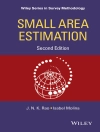An accessible introduction to performing meta-analysis across
various areas of research
The practice of meta-analysis allows researchers to obtain
findings from various studies and compile them to verify and form
one overall conclusion. Statistical Meta-Analysis with Applications
presents the necessary statistical methodologies that allow readers
to tackle the four main stages of meta-analysis: problem
formulation, data collection, data evaluation, and data analysis
and interpretation. Combining the authors’ expertise on the topic
with a wealth of up-to-date information, this book successfully
introduces the essential statistical practices for making thorough
and accurate discoveries across a wide array of diverse fields,
such as business, public health, biostatistics, and environmental
studies.
Two main types of statistical analysis serve as the foundation
of the methods and techniques: combining tests of effect size and
combining estimates of effect size. Additional topics covered
include:
* Meta-analysis regression procedures
* Multiple-endpoint and multiple-treatment studies
* The Bayesian approach to meta-analysis
* Publication bias
* Vote counting procedures
* Methods for combining individual tests and combining individual
estimates
* Using meta-analysis to analyze binary and ordinal categorical
data
Numerous worked-out examples in each chapter provide the reader
with a step-by-step understanding of the presented methods. All
exercises can be computed using the R and SAS software packages,
which are both available via the book’s related Web site. Extensive
references are also included, outlining additional sources for
further study.
Requiring only a working knowledge of statistics, Statistical
Meta-Analysis with Applications is a valuable supplement for
courses in biostatistics, business, public health, and social
research at the upper-undergraduate and graduate levels. It is also
an excellent reference for applied statisticians working in
industry, academia, and government.
Tabela de Conteúdo
Preface.
1. Introduction.
2. Various Measures of Effect Size.
2.1 Effect Size based on Means.
2.2 Effect Size based on Proportions.
2.3 Effect Size based on – Coefficient and Odds Ratio.
2.4 Effect Size based on Correlation.
3. Combining Independent Tests.
3.1 Introduction.
3.2 Description of Combined Tests.
4. Methods of Combining Effect Sizes.
5. Inference about a Common Mean of Several Univariate Normal
Populations.
5.1 Results on Common Mean Estimation.
5.2 Asymptotic Comparison of Some Estimates of Common Mean for k
= 2 Populations.
5.3 Confidence Intervals for the Common Mean.
5.4 Applications.
5.5 Appendix: Theory of Fisher’s Method.
6. Tests of Homogeneity in Meta-Analysis.
6.1 Model and Test Statistics.
6.2 An Exact Test of Homogeneity.
6.3 Applications.
7. One-Way Random Effects Model.
7.1 Introduction.
7.2 Homogeneous Error Variances.
7.3 Heterogeneous Error Variances.
8. Combining Controlled Trials with Normal Outcomes.
8.1 Difference of Means.
8.2 Standardized Difference of Means.
8.3 Ratio of Means.
9. Combining Controlled Trials with Discrete
Outcomes.
9.1 Binary Data.
9.2 Ordinal Data.
10. Meta-Regression.
10.1 Model with One Covariate.
10.2 Model with More Than One Covariate.
10.3 Further Extensions and Applications.
11. Multivariate Meta-Analysis.
11.1 Combining Multiple Dependent Variables from a Single
Study.
11.2 Modeling Multivariate Effect Sizes.
12. Bayesian Meta-Analysis.
12.1 A General Bayesian Model for Meta-Analysis under
Normality.
12.2 Further Examples of Bayesian Analyses.
12.3 A Unified Bayesian Approach to Meta-Analysis.
12.4 Further Results on Bayesian Meta-Analysis.
13. Publication Bias.
14. Recovery of Inter-Block Information.
14.1 Notations and Test Statistics.
14.2 BIBD with Fixed Treatment Effects.
15. Combination of Polls.
15.1 Formulation of the Problem.
15.2 Meta-Analysis of Polls.
16. Vote Counting Procedures.
17. Computational Aspects.
17.1 Extracting Summary Statistics.
17.2 Combining Tests.
17.3 Generalized P-values.
17.4 Combining Effect Sizes.
18. Data Sets.
18.1 Validity Studies.
18.2 Effects of Teacher Expectance on Pupil IQ.
18.3 Dentifrice Data.
18.4 Effectiveness of Amlodipine on Work Capacity.
18.5 Effectiveness of Cisapride on the Treatment of Nonulcer
Dyspepsia.
18.6 Secondhand Smoking.
18.7 Effectiveness of Misoprostol in Preventing Gastrointestinal
Damage.
18.8 Prevention of Tuberculosis.
References.
Index.
Sobre o autor
JOACHIM HARTUNG, Ph D, is Professor in the Department of
Statistics at the Dortmund University of Technology, Germany. He
has published several books and two dozen journal articles in the
field of statistics.
GUIDO KNAPP, Ph D, is Assistant Professor in the
Department of Statistics at the Dortmund University of Technology,
Germany. Dr. Knapp’s areas of research interest include variance
component models, error components regression models,
meta-analysis, and flexible design in clinical trials.
BIMAL K. SINHA, Ph D, is Presidential Research Professor
of Statistics in the Department of Mathematics and Statistics at
the University of Maryland at Baltimore County (UMBC). A Fellow of
both the Institute of Mathematical Statistics and the American
Statistical Association, Dr. Sinha’s research specializes in the
areas of multivariate analysis, mixed linear models, decision
theory, robustness, and environmental statistics.












